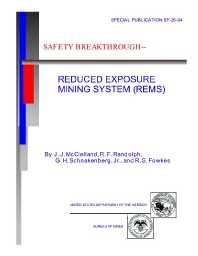Mining Publication: Safety Breakthrough -- Reduced Exposure Mining System (REMS)
Original creation date: January 1994
The face area of a continuous mining section of an underground coal mine is the most dangerous area in the mine. Workers there are at nearly twice the risk of death or disabling injury than those in other parts of the mine. Despite extensive training of miners and improved equipment and mining methods, fatality and injury rates have remained constant during the past few years. It is clear that advanced research is necessary to apply new technologies or modify work procedures to solve the continuing problem of the loss of lives and the numerous injuries at the mine face. A U.S. Bureau of Mines research program is developing a Reduced-Exposure Mining System (REMS) that relocates personnel operating the mining machinery at the face away from the hazards to a nearby haven of relative safety. REMS uses proven technologies of computer automation and robotics to help control the operation of the mining machines at the face, while personnel are moved away to a nearby, safe control room. In this protected, well-ventilated environment, they can supervise or control the operation of the machines while viewing what the machine is doing using video and graphic display monitors. REMS has the potential to be the single most important improvement in the safety and health of underground coal mine workers since the introduction and enforcement of the Federal Coal Mine Health and Safety Act of 1969. The REMS program is one of the more significant research efforts of the U.S. Bureau of Mines, Department of the Interior, which has been mandated by Congress to "conduct necessary research and development to improve working conditions and practices in coal and other mines...to prevent accidents...to develop new and improved underground and other equipment...which will provide greater safety." REMS clearly meets the requirements of this Congressional mandate. It has been developed to save lives and to minimize human suffering, and is the only research program to address the safety of the mining system at the mine face. In addition to protecting mine workers, REMS will redefine their roles, allowing them to operate in a more productive, environmentally-safe manner. REMS technology is also available and is being tried and tested for applications other than underground mining. Various aspects of its system can be adapted to improve productivity and protect workers in industries such as civil engineering and construction, nuclear and hazardous waste detection/cleanup.
Authors: JJ McClelland, RF Randolph, GH Schnakenberg, RS Fowkes
NIOSH/USBM Numbered Publication - January 1994
NIOSHTIC2 Number: 10012057
U.S. Department of the Interior, Bureau of Mines, Special Publication SP-26-94, 1994 Jan:1-38
See Also
- Diagnosing and Controlling Moisture-Sensitive Roof in Coal Mines
- Progress Toward Improved Engineering of Seals and Sealed Areas of Coal Mines
- Refuge Alternatives in Underground Coal Mines
- Safe and Economical Inerting of Sealed Mine Areas
- SPONCOM - A Computer Program for the Prediction of the Spontaneous Combustion Potential of an Underground Coal Mine
- Technology News 535 - NIOSH Releases New Educational Video: Escape from Farmington No. 9: An Oral History
- Technology News 545 - NIOSH Updates Spontaneous Combustion Assessment Software
- Ultra-Low Frequency Through-the-Earth Communication Technology
- Wireless Mesh Mine Communication System
- Work Sampling Applied to a Human Factors Analysis of Mine Worker Positioning
- Content source: National Institute for Occupational Safety and Health, Mining Program


 ShareCompartir
ShareCompartir
